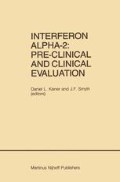Abstract
The data presented here summarize preclinical biological and biochemical data for highly purified, recombinant interferon (IFN) alpha-2 (Schering Corporation). These studies include (1) anti-tumor effects of IFN alpha-2 on malignant cells in culture and on human tumor xenografts in athymic nude mice; (2) anti-proliferative effects of IFN alpha-2 alone and in combination with cytotoxic drugs on cell lines and primary tumors in the human tumor clonogenic assay; (3) immunomodulation; and (4) evidence for the mediation of the biological activity of IFN alpha-2 through specific plasma membrane receptors. The significant results in each of these categories are summarized below.
In the human tumor xenograft model IFN alpha-2 has been shown to inhibit the growth of a human osteosarcoma, a human breast cancer and a human renal cell adenocarcinoma. Varying routes of administration were employed, including subcutaneous injection, intralesional administration and constant subcutaneous infusion for the three tumors, respectively. The data support that the human tumor xenograft model may be useful for predicting dose-response as well as the anti-tumor activity of alpha-2 and other IFN subtypes. In addition, studies with the renal cell adenocarcinoma indicate that combined therapy with IFN alpha-2 and difluoromethylornithine is more effective than single drug therapy. The mechanism by which IFN alpha-2 inhibits tumor cell growth appears to be related to a direct effect on tumor cell proliferation, rather than modulation of the mouse immune system.
A potent growth inhibitory effect of IFN alpha-2 was also observed in a number of normal and malignant human cell lines, including normal human amnion and breast cells, osteosarcoma, lymphoblastoid (Daudi), a T-cell lymphocytic leukemia (RPMI-8402) and a B-cell lymphocytic leukemia (BALM-2). The T-cell leukemia appeared to be markedly more sensitive than the B-cell leukemia. The human MOLT-3 T-cell lymphocytic leukemia, the murine P388 B-cell lymphocytic leukemia and a murine 239 Pu-induced osteogenic sarcoma were relatively insensitive.
Significant augmentation by IFN alpha-2 of the natural killer cytotoxicity of human peripheral blood monocyte-depleted lymphocytes against various hemopoietic cell lines and solid tumors has been observed. These data suggest that at least a part of the anti-tumor activity of IFN alpha-2 in man may be related to an indirect effect on the host immune system.
The first event in the expression of any biological activity of IFN appears to be the interaction with specific receptors on the cell surface. In an attempt to understand the biochemical basis for the various biological effects of IFN alpha-2, the binding of IFN alpha-2 to various human cell lines has been examined. Experiments employing I125-labelled IFN alpha-2 suggest that IFN-sensitive cells contain a macromolecular receptor on the surface of the plasma membrane. Quantitative studies indicate ca. 102,000 IFN alpha-2 receptors per Daudi cell. A correlation will be sought between the number and/or affinity of IFN alpha-2 for its receptor and the anti-proliferative response of various malignant cells.
Access this chapter
Tax calculation will be finalised at checkout
Purchases are for personal use only
Preview
Unable to display preview. Download preview PDF.
References
Nagabhushan TL, Surprenant H Le HV, Kosecki R, Levine A, Reichert P, Sharma B, Tsai H, Trotta P, Bausch Jr, Foster C, Gruber S, Hoogerheide J, Mercorelli S: Proc. of the Interferon Workshop, National Institutes of Health. In press.
Kelsey K: Treatment of a human osteosarcoma xenograft in Balb/c nude mice with IFN alpha-2. In prep.
Heston WDW, Fleischmann J, Tackett RE, Ratliff TL: Effects of alpha-difluoromethylornithine and recombinant interferon alpha-2 on the growth of a human renal cell osteosarcoma xenograft in nude mice. Cancer Res, submitted.
Sunkara PS, Prakash NJ, Mayer GD, Sjoerdsma A: Tumor suppression with a combination of alpha-difluoromethylornithine and interferon. Science 219: 851–853, 1983.
Taylor-Papadimitriou J, Shearer M, Balkwill FR, Fantes KH: Effects of human IFN alpha-2 and human IFN alpha (Namalwa) on breast cancer cells grown in culture and as xenografts in the nude mouse. J. Interferon Res. 2 (4): 479–491, 1982.
Higgins JA, Platsoucas CD: Immunomodulatory functions of E. coli - derived human alpha interferons. American Association of Immunologists (75th Meeting), St. Louis, Mo., 1984.
Lengyel P: Biochemistry of interferons and their actions. Ann Rev of Biochem 51: 251–282, 1982.
Friedman RM: Interferon binding: The first step in establishment of antiviral activity. Science 156: 1760–1761, 1967.
Ankel H, Chany C, Galliot B, Chevalier MJ, Robert M: Antiviral activity of interferon covalently bound to sepharose. Proc Nat’l Acad Sci (USA) 70: 2360–2363, 1973.
Besanscon F, Ankel H: Binding of interferon to gangliosides. Nature 252: 478–480, 1976.
Joshi AR, Sarkar FH, Gupta SL: Interferon receptors. Cross-linking of human leukocyte interferon alpha-2 to its receptor on human cells. J Biol Chem 257: 13884–13887, 1982.
Sarkar FH, Gupta SL: Interferon receptor interaction: Internalization of interferon alpha-2 and modulation of its receptors on human cells. Eur J Biochem. In press.
Faltynek CR, Branca AA, McCandless S, Baglioni C: Characterization of an interferon receptor on human lymphoblastoid cells. Proc Nat’l Acad Sci (USA) 80: 3269–3273, 1983.
Editor information
Editors and Affiliations
Rights and permissions
Copyright information
© 1985 Martinus Nijhoff Publishers, Boston
About this chapter
Cite this chapter
Trotta, P.P. (1985). Summary of Pre-clinical Data. In: Kisner, D.L., Smyth, J.F. (eds) Interferon Alpha-2: Pre-Clinical and Clinical Evaluation. Developments in Oncology, vol 27. Springer, Boston, MA. https://doi.org/10.1007/978-1-4613-2579-6_2
Download citation
DOI: https://doi.org/10.1007/978-1-4613-2579-6_2
Publisher Name: Springer, Boston, MA
Print ISBN: 978-1-4612-9618-8
Online ISBN: 978-1-4613-2579-6
eBook Packages: Springer Book Archive

